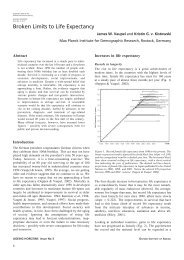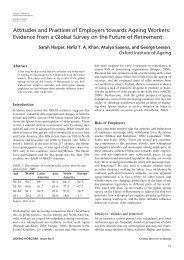Population Ageing in Central and Eastern Europe - Oxford Institute ...
Population Ageing in Central and Eastern Europe - Oxford Institute ...
Population Ageing in Central and Eastern Europe - Oxford Institute ...
You also want an ePaper? Increase the reach of your titles
YUMPU automatically turns print PDFs into web optimized ePapers that Google loves.
OXFORD INSTITUTE<br />
OF AGEING<br />
<strong>Oxford</strong> <strong>Institute</strong> of <strong>Age<strong>in</strong>g</strong><br />
1. Intro: From ‚Socialist‘ to ‚<strong>Age<strong>in</strong>g</strong>‘ Societies (2)<br />
Uncerta<strong>in</strong>ty, <strong>in</strong>security<br />
Did people change their behaviour / take different decisions?<br />
Mass emigration of young <strong>Eastern</strong> <strong>Europe</strong>ans to Western <strong>Europe</strong>, North<br />
America, Australia, etc.<br />
Young people <strong>in</strong> CEE stopped hav<strong>in</strong>g children (postponement)!<br />
Until today, little attention paid to causes of this extraord<strong>in</strong>ary fertility decl<strong>in</strong>e<br />
(Caldwell & Sch<strong>in</strong>dlmayr 2003)<br />
1. Is there population age<strong>in</strong>g <strong>in</strong> CEE?<br />
2. Is there a l<strong>in</strong>k between post-communist transformation <strong>and</strong> population<br />
age<strong>in</strong>g?<br />
This paper argues that population age<strong>in</strong>g <strong>in</strong> <strong>Central</strong> <strong>and</strong> <strong>Eastern</strong> <strong>Europe</strong> is<br />
an (un<strong>in</strong>tended) outcome of the socio-economic <strong>in</strong>security <strong>in</strong> the wake of<br />
the transformation of the CEE planned economies to market economies.





![ORAL PRESENTATIONS [pdf] - Oxford Institute of Ageing](https://img.yumpu.com/37918222/1/184x260/oral-presentations-pdf-oxford-institute-of-ageing.jpg?quality=85)




